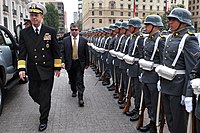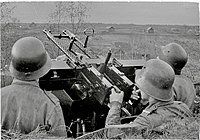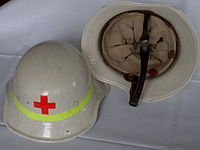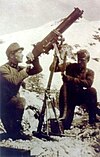Stahlhelm
| Stahlhelm | |
|---|---|
 M35 on display inside Historical Museum Rotterdam | |
| Type | Combat helmet |
| Place of origin | Germany |
| Service history | |
| In service | 1916–1992 |
| Used by | See Users |
| Wars | World War I German Revolution Chinese Civil War Winter War World War II Korean War |
| Production history | |
| Designer | Dr. Friedrich Schwerd |
| Designed | 1915 |
| Produced | 1916 |
| Variants | See Variants |
The Stahlhelm ('steel helmet') is a German military steel combat helmet intended to provide protection against shrapnels and fragments or shards of grenades. The term Stahlhelm refers both to a generic steel helmet and more specifically to the distinctive German military design.
The armies of major
Development
At the beginning of World War I, none of the combatants were issued with any form of protection for the head other than cloth and leather caps, designed at most to protect against sabre cuts. When trench warfare began, the number of casualties on all sides suffering from severe head wounds (more often caused by shrapnel bullets or shell fragments than by gunfire) increased dramatically, since the head was typically the most exposed part of the body when in a trench. The French were the first to see a need for more protection—in mid-1915 they began to issue Adrian helmets to their troops.[2][3] The British and Commonwealth troops followed with the Brodie helmet (a development of which was also later worn by US forces) and the Germans with the Stahlhelm.
As the German army hesitated to develop effective head protection, some units developed provisional, makeshift helmets in 1915. Stationed in the rocky area of the Vosges the Army Detachment "Gaede" recorded significantly more head injuries caused by stone and shell splinters than did troops in other sectors of the front. The artillery workshop of the Army Detachment developed a helmet that consisted of a leather cap with a steel plate (6 mm thickness). The plate protected not only the forehead but also the eyes and nose.[4][5]
The Stahlhelm was quite deep relative to the thickness of the steel; one American company that tried to press steel of similar thickness into the shape of the much shallower Brodie helmet was unable to do so..
History
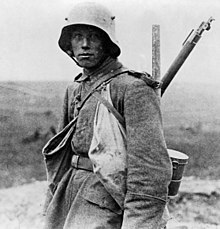
The design of the Stahlhelm was carried out by Dr Friedrich Schwerd of the Technical Institute of Hanover. In early 1915, Schwerd had carried out a study of head wounds suffered during trench warfare and submitted a recommendation for steel helmets, shortly after which he was ordered to Berlin. Schwerd then undertook the task of designing and producing a suitable helmet,[7] broadly based on the 15th-century sallet, which provided good protection for the head and neck.[8]
After lengthy development work, which included testing a selection of German and Allied headgear, the first stahlhelm were tested in November 1915 at the Kummersdorf Proving Ground and then field-tested by the 1st Assault Battalion. Thirty thousand examples were ordered, but it was not approved for general issue until New Year of 1916, hence it is most usually referred to as the "Model 1916". In February 1916 it was distributed to troops at Verdun, following which the incidence of serious head injuries fell dramatically. The first German troops to use this helmet were the stormtroopers of the Sturm-Bataillon Nr. 5 (Rohr), commanded by Captain Willy Rohr.
In contrast to the Hadfield steel used in the British Brodie helmet, the Germans used a harder martensitic silicon/nickel steel. As a result, and also due to the helmet's form, the Stahlhelm had to be formed in heated dies at a greater unit cost than the British helmet, which could be formed in one piece.[9]
Like the British and French, German troops identified highly with their helmets. The Stahlhelm became a popular symbol of paramilitary groups after the First World War. Such was the attachment of the World War One generation to the design that it was reportedly the reason that Hitler rejected a modernised, sloping helmet design to replace it.[10]
Stahlhelm use in other countries
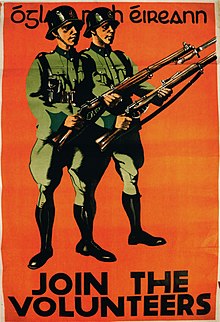
Germany exported versions of the M1935 helmet to various countries. Versions of the M1935 Stahlhelm were sent to
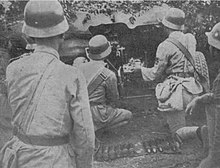
Some countries manufactured their own helmets using the M1935 design, and this basic design was in use in various nations as late as the 1970s.
The Germans helped the Hungarians copy the M1935 design. The WWII M38 Hungarian steel helmet is nearly identical to the German M1935. Both have almost the same shape, riveted ventilation holes, and the classic rolled edge. Differences include somewhat rougher Hungarian finishing, a different liner and different rivets position – the split pins are situated behind the ventilation holes. A square metal bracket is riveted on the rear, above the back brim, to secure the helmet to the knapsack while marching. It was typically painted in Hungarian brown-green, though blue-grey versions existed. It is sometimes called the "Finnish M35" due to its extensive use by the Finnish Army during the Continuation War 1941–44.
After World War I
During the time of the
In November 1926, the
Switzerland used a helmet, designated the M1918, that was roughly similar to the M1916 but had a shallower, wider and more rounded crown and skirt. This was to protect against the harsh winter winds of the alpine regions.
The
and synthetic ballistic fiber helmets by that time. A Stahlhelm with crossed bayonets and the corresponding number is the standard insignia of infantry regiments.The Imperial Iranian Army used small numbers of the Vulkanfiber model, mostly with the Imperial Guard and a few units around Tehran, acquired prior to the Anglo-Soviet invasion of Iran.
During World War II, the
In the Socialist Federal Republic of Yugoslavia, due to large quantities captured by World War II Partisans, the Stahlhelm was used in Yugoslav People's Army up to 1959, when it was phased out and replaced by the M59/85 steel helmet.
Postwar

After World War II,
The U.S. Army's 1980s and 1990s era
The Chinese People's Liberation Army soldiers still used M1935 helmets which were captured from the Chinese Nationalist Army during the Chinese Civil War until the 1970s.
Since 2012, El Salvador's Policia Nacional Civil use a navy/indigo blue-coloured helmet that strongly resembles the Stahlhelm; this helmet is used by some members of the riot-control unit and rarely used by the Police's assault teams.
German Reunification
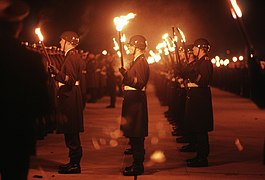
With German reunification and the absorption of the National Peoples Army into the Bundeswhr. notably a variation of the Stahlhelm is used when conducting German military traditions.[21]
-
Chilean honour guard next to U.S. AdmiralMichael G. Mullenin March 2009
-
German firefighting helmet
-
Chinese soldiers of the National Revolutionary Army wearing Stahlhelme before the battle of Wuhan
-
Finnish AA-MG crew in 1942. The soldier in the middle has a Austro-Hungarian M1917 and the others have Hungarian M38 helmets.
-
GermanCivil defenceStahlhelm with wider, flared peak in use from the 1940s until the 1990s
-
Afghan Army soldiers wearing Stahlhelme, 1950s
-
Ukrainian Euromaidan protester wearing Stahlhelm with SS insignia, 2014. The inscription says "Putin, think or you'll end up like Hitler".
Variants
The different Stahlhelm designs are named for their year of introduction. For example, the Modell 1942 which was introduced in 1942 is commonly known as M1942 or simply M42. Here, they are referred to by their M19XX names.
M1916 and M1917

The Stahlhelm was introduced into regular service during the Verdun campaign in early 1916.
The M1916 design had side-mounted horn-like ventilator lugs which were intended to support an additional steel brow plate or Stirnpanzer, which saw limited use only by snipers and trench raiding parties, as it was too heavy for general use.[22]
The shell came in different sizes, from 60 to 68, with some size 70s reported. Helmet weight varied from 0.98 kg to 1.4 kg, depending on shell size. The suspension, or liner, consisted of a headband with three segmented leather pouches, each holding padding materials, and leather or fabric cords that could be adjusted to provide a comfortable fit. The one-piece leather chin strap was attached to the shell by M1891 chinstrap lugs, the same kind used in the Pickelhaube helmet.
The M1916 design provided excellent protection. Reserve Lieutenant Walter Schulze of 8th Company Reserve Infantry Regiment 76 described his combat introduction to the helmet on the Somme, 29 July 1916:
... suddenly, with a great clanging thud, I was hit on the forehead and knocked flying onto the floor of the trench... a shrapnel bullet had hit my helmet with great violence, without piercing it, but sufficiently hard to dent it. If I had, as had been usual up until a few days previously, been wearing a cap, then the Regiment would have had one more man killed.[23]
But the helmet was not without its flaws. The ventilator horns often let cold air in during the winter, requiring the wearer to block the vents with mud or fabric. The large, flared skirt tended to make it difficult for soldiers to hear, distorting surrounding sounds and creating an echo when the wearer spoke.
Originally painted Feldgrau (field grey), the Stahlhelm was often camouflaged by troops in the field using mud, foliage, cloth covers, and paint. Official issue cloth covers in white and grey appeared in late 1916 and early 1917. Camouflage paint was not formally introduced until July 1918, when German Army Order II, No 91 366, signed by General Erich Ludendorff on 7 July 1918, outlined official standards for helmet camouflage. The order stipulated that helmets should be painted in several colours, separated by a finger-wide black line. The colours should be relevant to the season, such as using green, brown and ochre in summer.[22] In the closing months, some experiments were conducted on the Stahlhelm paint. Wollstaub was one such paint iteration that was infused with crushed felt in hopes of glare reduction.
After the effectiveness of the M1916 design was validated during the 1916 campaigns, incremental improvements were subsequently made. The M1917 version saw improvements to the liner but was otherwise identical to the original design.
M1918
Extensive redesigns were made for the M1918 model. A new two-piece chin strap was introduced and was attached directly to the helmet liner rather than the shell. Certain examples of the M1918 had cutouts in the rim along the sides of the helmet. This iteration was dubbed the cavalry or telephone talker helmet, despite the fact that it was intended to be utilized by all units. It has incorrectly been said that these cutouts were to accommodate headphones while wearing the helmet. These cutouts were actually done to improve hearing and to reduce echo created by the large, flared skirt. About ten thousand were created in the closing months of the war.
The M1918 Stahlhelm can be distinguished from the M1916, as the M1918 shell lacks the chinstrap rivet on the lower side of the helmet skirt found on earlier models.
A modified variant of the M1918 was also made, referred to as the Armored Warfare Stahlhelm, created in sparing amounts for tank crews. The only difference from previous models was the reduction of the visor extending over the eyes to allow for better visibility.
Austro-Hungarian variants

Austria-Hungary purchased about 416,000 German helmets from November 1916 until the end of the war and also began its own licensed production starting in May 1917. Around a million Stahlhelm of all variants were issued until the end of the war.[24]
Austro-Hungarian M17
The Austrian M17 helmet was similar to the German M16, it was indicated „nach deutschem Muster“ i.e. "German modell". It was coloured golden-brown (known as
- Adolf Westen factory in Celje, present day Slovenia
- Brüder Gottlieb u. Brauchbar in Brno, present day Czech Republic
- Bleckmann & Poldihutte in Kladno, present day Czech Republic
- C. A. Scholtz in Matejovce, Poprad, present day Slovakia
- Nădrag, present day Romania
- Reșița, present day Romania
- Weiss Manfréd Acél- és Fémművek in Csepel, Budapest, present day Hungary
- Bruder Lapp in Rottenmann, present day Austria
- Warchalowski, Eissler & Co in Vienna, present day Austria
- Gebruder Bohler & Co. in Kapfenberg, present day Austria.[25]
Austro-Hungarian M18
This helmet is known by collectors as Hungarian M18 variant and it was similar to the Austrian M17 design, but the chinstrap rivet was smaller in size and located even higher up than the Austrian version. It was coloured in golden-brown (known as
Berndorfer variant
There was also a quite different, domestically developed Berndorfer variant. It was indicated as "österreichisches Muster" i.e. Austrian mode. 139,968 were produced from May till November 1917 at the Krupp in Berndorf.[24]
Ottoman variant
The formation in 1917 by the Ottoman Empire of stormtrooper battalions following the German model prompted the requirement for steel helmets, as these had not previously been adopted. Although German helmets were ordered, Ottoman officers believed that the design impeded the soldiers' ability to hear orders in the field and requested that the visor, ear and neck protectors be removed, which was done using grinding machines.[26] Germany delivered 5,400 visorless versions of the M1918 helmet for the Ottoman Empire. The missing front visor was thought by the Germans to be for religious reasons,[27] and it was claimed that it was to allow Turkish soldiers to touch their foreheads to the ground during prayer, without removing their helmets. However, this story has been disputed. The Turks rejected any more than the 5,400 delivered and an unknown number from the overrun were issued to German armed forces and were used by German Freikorps units after the war.
M1933

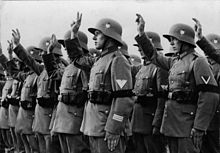

In 1932 the Army High Command ordered the testing of a new prototype helmet intended to replace the older models. It was made entirely from a composite plastic material called "Vulkanfiber". The Model 1933 Vulkanfiber helmet kept the basic form of previous helmets but was much lighter. It was put into limited production following favourable field tests in early 1933 and small numbers were issued to Reichswehr infantry, artillery and communications units. It was removed from service following the introduction of the M1935 helmet and most of the remaining stock were reissued to civil organizations such as fire brigades and police forces.[28] Some examples were also retained for parade use by senior officers, who were not generally issued with the Stahlhelm.
M1935
In 1934 tests began on an improved Stahlhelm, whose design was a development of World War I models. The company "Eisenhüttenwerke Thale" (today Thaletec) carried out prototype design and testing, with Dr Friedrich Schwerd once again taking a hand.
The new helmet was pressed from sheets of molybdenum steel in several stages. The size of the flared visor and skirt was reduced, and the large projecting lugs for the obsolete armour shield were eliminated. The ventilator holes were retained but were set in smaller hollow rivets mounted to the helmet's shell. The edges of the shell were rolled over, creating a smooth edge along the helmet. Finally, a completely new leather suspension, or liner, was incorporated that greatly improved the helmet's safety, adjustability, and comfort for each wearer. These improvements made the new M1935 helmet lighter, more compact, and more comfortable to wear than the previous designs.
The Army's Supreme Command within the Third Reich's Wehrmacht or combined armed forces officially accepted the new helmet on June 25, 1935 and it was intended to replace all other helmets in service.[28]
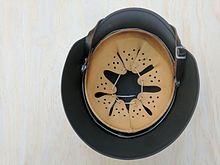
More than 1 million M1935 helmets were manufactured in the first two years after its introduction, and millions more were produced until 1940 when the basic design and production methods were changed.
Gladiator civil defense helmet

In 1938, the Germans developed a variant of the Stahlhelm with a wider, flared peak and ventilation holes originally intended for
M1940
The M1935 design was slightly modified in 1940 to simplify its construction, the manufacturing process now incorporating more automated stamping methods. The principal change was to stamp the ventilator hole mounts directly onto the shell, rather than utilizing separate fittings. In other respects, the M1940 helmet was identical to the M1935. The Germans still referred to the M1940 as the M1935, while the M1940 designation were given by collectors.[35]
Fallschirmjäger version


A variant of the M1935 helmet with a shell lacking the projecting visor and deep flared rim was issued to
M1942
The M1942 design was a result of wartime demands, by order of Hitler, to ‘maintain intimidation but reduce cost’. The rolled edge on the shell was eliminated, creating an unfinished edge along the rim. This edge slightly flared out, along the base of the skirt, reducing the protection the helmet gave. The elimination of the rolled edge expedited the manufacturing process and reduced the amount of metal used in each helmet. Shell paint colours were typically matte grey-green (Heer) or grey-blue (Luftwaffe), and the decals were eliminated in 1943 to speed up production and reduce the helmet's combat visibility. Greater manufacturing flaws were also observed in M1942 helmets made late in the war.[37]
M1944
A new variant, designed in 1942 by the Institute for Defence Technical Materials Science in Berlin, was the so called M44. It was stamped out of one piece of metal, but with sloped sides. It was similar in appearance to the
M1945
There have been reports of a variant manufactured in the last months of the war. The M1945 was reported to have been similar to the M1942 design but did away completely with the ventilator. These helmets are reported to be extremely rare. Many collectors and historians are of the opinion that the M1945 helmet is just a regular M1942 helmet that lacked the vents simply because of machine malfunctions in the factory, or unfinished M1942 helmets that were completed in the post-war era.[37]
East Germany
M1954
It was an evolution of the prototype M1944 with a modified and more squared line. The appearance of the helmet was a transitional way between the M35 and the M44. It was nicknamed Kesslerbombe with reference to the General Keßler. It was used by the KVP of the DDR and it was fitted with two different suspension systems during its life in service. The first one fixed with three rivets as in the WW2 models, the second type required further holes in the helmet shell. It was substituted by the helmet M1956.
M1956

The
The design was not used until the requirement for a distinct German helmet for the
The M-56 helmet came in three basic versions, Mod 1 or I/56, Mod 2 or I/57 and Mod 3 or I/71, and was widely sold (or given) to Third World armies.
West Germany
M40/51
When the Bundesgrenzschutz (BGS) (Federal Border Guards of Germany) was formed in 1951, it was supplied with old salvaged and refurbished M35, M40 or M42 helmets. Among the changes made, there was the replacement of the interior and the introduction of new eyelets for the chinstrap, some welded inside the helmet some even fixed to the helmet with rivets. The helmets for the BGS were repainted in dark green RAL 6012.
With the progressive depletion of stocks, starting from 1951 new helmets were produced following the construction rules of the M40 model. Regarding the interior, was used the simplified M31 type, with a chinstrap directly fixed to it, (adopted above all by the police forces of the Länder), and a liner with a chinstrap fixed to the helmet according to the methods described above; this version was adopted by the BGS.
M40/53
Starting from 1953 a further update of the interior was introduced with the type called I53, developed by the company Schuberth Werke Braunschweig.
This interior was no longer fixed with the classic three nails that ran along the helmet shell but by a screw placed inside, in the center of the upper part of the helmet.
For this reason the helmet is recognizable from the previous versions by the absence of the rivets on the shell. In later versions, the ventilation holes were also removed. As regards to the fastening of the chinstrap, were used the same solutions of the previous model.
Bundeswehr M56
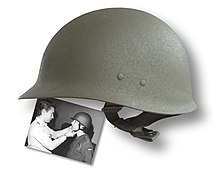
The West German M-56 Stahlhelm was a direct copy of the U.S. M1 helmet. It was properly called "zweiteiliger Stahlhelm" (two-piece steel helmet). In 1958 the helmet was made as a one-piece helmet and renamed Stahlhelm M1A1. The M1A1 came in three sizes: 66, 68, and 71. This helmet was used until 1981 when a modified version was released and renamed the Helm1A1. Modifications included a 3-point chin strap with the third point connecting at the nape, extra-large sizes, and a further adjustable liner.[40]
The M1A1 Stahlhelm remained in service until 1992 when the Bundeswehr replaced it with a PASGT-derived kevlar helmet called the Gefechtshelm ("Combat helmet").
Decals and insignia
After Stahlhelm shells were painted, the colours of which varied by organization, small identification or insignia
The combined Wehrmacht military forces of Nazi Germany consisted of the
For the Chinese Nationalist Army soldiers, their M35 helmets were stencilled with the Chinese Nationalist Insignia on the left side. Bolivian Army personnel carry the national flag decal on their Stahlhelms when in the full dress.
Fiction
- The German Stahlhelm, as well as the Japanese Kabuto, served as a template for the fictional character Darth Vader's headgear in the Star Wars franchise.
- Improved and bulletproof Stahlhelms with integrated gas masks are part of the German-originated "Protect Gear" powered exoskeletons in Mamoru Oshii's Kerberos Saga franchise.
- Transformers: Animated features Blitzwing owning a helmet similar to a German Stahlhelm.
- Super Robot Monkey Team Hyper Force Go!features alien troopers conjured by the Wigglenog wearing helmets similar to Stahlhelms in "Meet the Wigglenog".
Users
This section needs additional citations for verification. (March 2019) |
This section is missing information about which specific kinds — at minimum, whether it’s from the classical coal-scuttle line or either of the M-56s. (December 2021) |
 German Empire (M16-18)
German Empire (M16-18) Austria-Hungary
Austria-Hungary Weimar Republic
Weimar Republic Nazi Germany (M35~M42)
Nazi Germany (M35~M42) East Germany (M56)
East Germany (M56) West Germany (for Bundesgrenzschutz use, copies of M35)
West Germany (for Bundesgrenzschutz use, copies of M35)
 Republic of China (1912–1949) (M35)
Republic of China (1912–1949) (M35) People's Republic of China (M35, Captured from the Nationalists)
People's Republic of China (M35, Captured from the Nationalists) Ottoman Empire
Ottoman Empire Imperial State of Iran
Imperial State of Iran Kingdom of Afghanistan (M18 Hungarian model, purchased from Czechoslovakia in the 1930s)[42]
Kingdom of Afghanistan (M18 Hungarian model, purchased from Czechoslovakia in the 1930s)[42] Irish Free State in 1926-1940 [clarification needed]
Irish Free State in 1926-1940 [clarification needed] Dominican Republic
Dominican Republic Italy
Italy Hungary
Hungary Bulgaria (M36)
Bulgaria (M36) Cambodia
Cambodia Finland
Finland Estonia (M16-18)
Estonia (M16-18) M1926)[citation needed]
M1926)[citation needed]
 Spain
Spain Yugoslavia
Yugoslavia Belgium
Belgium Czechoslovakia
Czechoslovakia Colombia
Colombia Chile
Chile Bolivia
Bolivia Argentina A hardboard local made helmet called M38 was used between 1938 and 1956.
Argentina A hardboard local made helmet called M38 was used between 1938 and 1956. Mexico (limited use of M1916, replaced by M26 Adrian Helmets in 1938)[45]
Mexico (limited use of M1916, replaced by M26 Adrian Helmets in 1938)[45] Latvia (M16, M1918)[46][47]
Latvia (M16, M1918)[46][47] Libya
Libya Lithuania (M1918)
Lithuania (M1918) Norway - used by the Norwegian Armed Forces from 1945 until the introduction of the American M1 helmet in the late 1950's
Norway - used by the Norwegian Armed Forces from 1945 until the introduction of the American M1 helmet in the late 1950's Poland – interwar Polish state issued WW1 stahlhelms to Border Protection Corps, 10th Motorized Cavalry Brigade, and state police units. During the World War II helmets captured from the German occupying force were used by Polish underground formations.
Poland – interwar Polish state issued WW1 stahlhelms to Border Protection Corps, 10th Motorized Cavalry Brigade, and state police units. During the World War II helmets captured from the German occupying force were used by Polish underground formations. Russian White movement - supplied by Germany to West Russian Volunteer Army troops in the Russian Civil War.
Russian White movement - supplied by Germany to West Russian Volunteer Army troops in the Russian Civil War. Tunisia (used by National Guard in 60s and spotted in Battle of Ben Guerdane. Picture of a Tunisian national guard officer wearing a Stahlhelm )
Tunisia (used by National Guard in 60s and spotted in Battle of Ben Guerdane. Picture of a Tunisian national guard officer wearing a Stahlhelm ) Turkey[48]
Turkey[48] Croatia M56[49]
Croatia M56[49] Independent State of Croatia
Independent State of Croatia Venezuela
Venezuela Vietnam (The M56 East German helmet was supplied to People's Army of Vietnam and Viet Cong troops in the Vietnam War)[citation needed]
Vietnam (The M56 East German helmet was supplied to People's Army of Vietnam and Viet Cong troops in the Vietnam War)[citation needed]
See also
- Pickelhaube
- Sallet
- Der Stahlhelm
- Wehrmacht uniforms
- Brodie helmet
- Adrian helmet
- SSh-36
Notes
- ^ jwh1975 (10 April 2016). "WWII equipment of the Bundesgrenzschutz". wwiiafterwwii. Retrieved 14 May 2018.
{{cite web}}: CS1 maint: numeric names: authors list (link) - ^ Suciu, Peter (2 February 2009). "The first modern steel combat helmet: the French 'Adrian'". Military Trader. Archived from the original on 26 July 2011. Retrieved 13 April 2014.
- ^ "Infantry Helmets". Militaryheadgear.com. 1 January 2008. Retrieved 13 April 2014.
- ^ "German Spare Parts". jonsmith-modellbau.com. Retrieved 26 November 2016.
- ^ "WKI Gaede Stahlhelm". zib-militaria.de. Retrieved 26 November 2016.
- ^ Tenner, Edward, and Edward Tenner. Our own devices: The past and future of body technology. New York: Alfred A. Knopf, 2003, p.252
- ^ Tubbs & Clawson (2000), p. 10.
- ^ Tenner, Edward (Summer 2003). "Hardheaded Logic: The Helmet is older than the city-state and newer than the airplane". American Heritage. 19 (1). Archived from the original on 28 August 2008.
- ISBN 0-85045-569-3.
- ^ Tenner, Edward, and Edward Tenner. Our own devices: The past and future of body technology. New York: Alfred A. Knopf, 2003, pp. 252–253
- ^ Thompson, Glenn (5 October 2014). "Artefacts: Vickers helmet". History Ireland. Retrieved 28 September 2018.
- ^ "Mº 35 de fibra". cascoscoleccion.com. Retrieved 14 April 2018.
- ^ "Mº 35 de fibra". cascoscoleccion.com. Retrieved 14 April 2018.
- ^ "Mº Alemán ejército (fibra)". cascoscoleccion.com. Retrieved 14 April 2018.
- ^ "Mº 35 (FAMAE)". cascoscoleccion.com. Retrieved 14 April 2018.
- ISBN 9780982806302.
- ISBN 9780982806302.
- ^ "Historia de los cascos modelo alemán en uso en el Ejército de Chile" (PDF). Anuario de Historia Militar N.° 16. Retrieved 1 February 2024.
- ^ a b Tubbs & Clawson (2000), pp. 80–81.
- ^ Mexicalisport, Redacción (18 September 2015). "UABC MEXICALI CAMPEONES DE LA 1RA COPA LEONES DE BANDAS DE GUERRA – MexicaliSport" (in European Spanish). Retrieved 8 February 2019.
- ^ "Der Große Zapfenstreich: Die feierlichste Zeremonie der Bundeswehr". www.bundeswehr.de (in German). 1 June 2022. Retrieved 16 December 2023.
- ^ ISBN 1-84176-198-2.
- ^ Sheldon (2007), p. 219, quoted and translated from Gropp, History of IR 76, p. 159.
- ^ ISBN 978-3-9501642-1-3.
- ^ "About WWI & WWII German & Austro-Hungarian Helmets". Alexander & Sons Restorations. Archived from the original on 7 July 2015. Retrieved 26 November 2016.
- ISBN 978-3110552898.
- ^ Tubbs & Clawson (2000), p. 24.
- ^ ISBN 1-84176-725-5.
- ISBN 978-1476620886. Retrieved 28 September 2018 – via Google Books.
- ISBN 978-0873386777. Retrieved 28 September 2018 – via Google Books.
- ^ Gentile, Mannie (12 October 2008). "Mannie Gentile: Combat Helmets of the 20th Century: German Luftschutz Helmet". Retrieved 28 September 2018.
- ^ "Picture of Feldgrum Volkssturm helmet". Retrieved 28 September 2018.
- ^ "Volkssturm helmet". Retrieved 28 September 2018.
- ^ "Steel Helmet, M44 Luftschutz". Imperial War Museums. Retrieved 28 September 2018.
- ^ "M35 Stahlhelm vs. M40 Stahlhelm". Helmet History. Luftm40. Archived from the original on 26 November 2016. Retrieved 5 June 2013.
- ^ Dunford, Jeffrey Lynn. "Weapons and Equipment of the Fallschirmjäger". Feldgrau.com. Retrieved 13 April 2014.
- ^ a b "World War II Combat Helmet Types". German-Helmets.com. Retrieved 13 April 2014.
- ^ Hancock, M. Donald (1973). The Bundeswehr and the National People's Army: A Comparative Study of German Civil-Military Polity. University of Denver. p. 25.
- ^ Baer, Ludwig (1977). Die Geschichte des Deutschen Stahlhelmes: von 1915 bis 1945; seine Geschichte in Wort u. Bild [The history of German steel helmets: from 1915 to 1945; their story in words & pictures] (in German). Eschborn: L. Baer (Selbstverlag).
- ^ Lucy, Roger (January 2015). ""Euroclones": An essential guide to postwar steel helmets". OCAD Militaria Collectors Resource. Archived from the original on 11 September 2017. Retrieved 26 November 2016.
- ^ "Collector Topics: Helmet Decals". German-helmets.com. Retrieved 13 April 2014.
- ISBN 978-1-4728-0179-1. Retrieved 25 July 2023.
- ^ "Greek Troops". Getty Images.
- ^ "Elas Troops with Guns and Rifles". Getty Images.
- ^ "Mexico". Maharg Press. Retrieved 12 November 2018.
- ^ Dambītis, Kārlis (2016). Latvijas armijas artilērija 1919.-1940.g.: Vieta bruņotajos spēkos, struktūra un uzdevumi [Artillery of the Latvian Army (1918–1940): structure, tasks and place in the Armed forces] (PhD thesis). University of Latvia. p. 178, 230.
- ISBN 978-1-300-01591-8.
- ^ "German Gaede Skull Cap Portuguese Helm Italian Farina Helmet Stahlhelm Mod 1916 Turkish Stahlhelm Pickelhaube British Brodie Helm French Toque Berndorfer Helm Adrian Helmet Sohlberg Helm M17 Belgian Adrian | Love Meme on ME.ME". me.me. Retrieved 8 February 2020.[permanent dead link]
- ^ "Croatia M56/76".
References
- Sheldon, Jack (2007). The German Army on the Somme 1914–1916. Barnsley, South Yorkshire, UK: Pen & Sword Military. OCLC 72868781.
- Tubbs, Floyd R.; Clawson, Robert W. (2000). Stahlhelm: Evolution of the German Steel Helmet (Revised and expanded ed.). Kent, Ohio: Kent State University Press. OCLC 43706682.
- Krause, Jürgen (1984). "Stahlhelme vom Ersten Weltkrieg bis zur Gegenwart" [Steel helmets from the First World War to the present] (PDF). Veröffentlichungen des Bayerischen Armeemuseums. Vol. 8 (in German). Archived from the original (PDF) on 24 September 2015. Retrieved 13 August 2016. Special exhibition at Bayerisches Armeemuseum, Ingolstadt.
- Collecting German WW2 helmets in the 21st century : https://germanhelmetvault.com/

